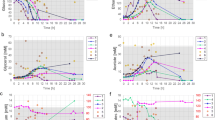Abstract
This work is based on the importance of monitoring the thermodynamic variables of sugarcane juice fermentation by Saccharomyces cerevisiae, using a numerical technique, and providing artifices that lead to the best performance of this bioprocess. Different combinations of yeast quantity were added to diverse dilutions of cane juice, allowing the evaluation of the fermentation performance. This was conducted by observing the temperature signal obtained from thermal probes inserted in the experimental set up. The best performances are utilized in the mathematical model evaluation. Thus, the signal reconstructed by the appropriate inverse problem and subsequently, regularized by the simplified method of least squares (the method used for adjusting the defined parameters) allows a common method to process the convection coefficient that can be monitored and controlled within an actuation range. This leads to an increased level of refinement in the technique. Results show that it is possible to determine the best parameters for this technique and observe the occurrence of fermentation by monitoring the temperature signal, thereby ensuring the realization of a high-quality and high-performance bioprocess.






Similar content being viewed by others
References
Balat M, Balat H, Oz C (2008) Progress in bioethanol processing. Prog Energy Combust 34:551–573
Bayer FM, Kozakevicius AJ (2010) SPC-threshold: Uma proposta de limiarização para filtragem adaptativa de sinais. TEMA Tend Mat Apl Comput 11:121–132
Bazán FSV, Borges LS (2004) In: Barcelos CAZ, Andrade EXL, Boaventura M (eds) Notas em Matemática Aplicada. SBMAC, São Carlos
British Petroleum Global (2017) BP statistical review of World energy. http://www.bp.com/content/dam/bp/pdf/energy-economics/statistical-review-2016/bp-statistical-review-of-world-energy-2016-full-report.pdf. Accessed 3 Feb 2017
Colaço MJ, Orlande HRB (2004) Inverse natural convection problem of simultaneous estimation of two boundary heat fluxes in irregular cavities. Int J Heat Mass Transf 47:1201–1215
Corazza ML, Rodrigues DG, Nozaki J (2001) Preparation and characterization of orange wine. Quím Nova 15:449–452
Donoho DL, Johnstone IM (1994) Ideal spatial adaptation by wavelet shrinkage. Biometrika 81:425–455
Incropera FP, Dewit DP, Bergman DL, Lavine AS (2008) In: Queiroz EM, Pessoa FLP (eds) Fundamentos de transferência de calor e de massa, 6th edn. LTC, Rio de Janeiro
Kobayashi M, Nagahisa K, Shimizu H, Shiova S (2006) Simultaneous control of apparent extract and volatile compounds concentrations in low-malt beer fermentation. Appl Microbiol Biotechnol 73:549–558
Kozakevicius AJ, Bayer FM (2014) Signal denoising via wavelet thresholding. Cien Nat 36:37–51
Kumar S, Dheeran P, Singh SP, Mishra IM, Adhikari DK (2013) Cooling system economy in ethanol production using thermotolerant yeast Kluyveromyces, sp. IIPE453. J Microbiol Res 1:39–44
Lima UA, Basso LC, Amorim HV (2001) In: Lima UA, Aquarone E, Borzani W, Schmidell W (eds) Biotecnologia industrial. Edgard Blücher, São Paulo
Liu CS, Kuo CL, Jhao WS (2016) The multiple-scale polynomial Trefftz method for solving inverse heat conduction problems. Int J Heat Mass Transf 95:936–943
Mirsephai A, Mohammadzaheri M, Chen L, O’Neill B (2012) An artificial intelligence approach to inverse heat transfer modeling of an irradiative dryer. Int Commun Heat Mass Transf 41:19–27
Mohanraj K, Nair NV (2014) Biomass potential of novel interspecific hybrids involving improved clones of Saccharum. Ind Crop Prod 53:128–132
Oliveira J, Santos JN, Seleghim P Jr (2006) Inverse measurement method for detecting bubbles in a fluidized bed reactor—toward the development of an intelligent temperature sensor. Powder Technol 169:123–135
Paz PM, Oliveira J (2013) Use of a numerical technique for monitoring of convection coefficient in industrial processes. In: 22nd international congress of mechanical engineering. http://www.abcm.org.br/anais/cobem/2013/PDF/322.pdf Accessed 20 Jan 2017
Peixoto CRM, Rosa GR, Silva CN, Santos BT, Engelmann L (2012) Miniprojeto para ensino de química geral experimental baseado na fermentação do caldo de cana de açúcar. Quím Nova 35:1686–1691
Salvadó Z, Arroyo-López FN, Barrio E, Querol A, Guillamón JM (2011) Quantifying the individual effects of ethanol and temperature on the fitness advantage of Saccharomyces cerevisiae. Food Microbiol 28:1155–1161
Tikhonov AN, Arsenin VY (1977) Solutions of ill-posed problems. Wiley, New York
Acknowledgements
We sincerely thank Prof. Dr. Karina Alves de Toledo, for permitting us to use the Laboratory of Cellular and Molecular Immunology, UNESP, FCLA for performing the fermentation experiments, and Prof. Dr. Paulo Seleghim Júnior, from NETeF, USP, São Carlos for providing the thermocouples, used in the experiment. Finally, we thank the Scientific Initiation Program of UNESP—PIBIC/PROPe, for the funding provided in 2015 and their collaboration for this study.
Author information
Authors and Affiliations
Corresponding author
Rights and permissions
About this article
Cite this article
da Paz, P.M., de Oliveira, J. Monitoring the convection coefficient in fermentative processes using numerical methods. Bioprocess Biosyst Eng 41, 697–706 (2018). https://doi.org/10.1007/s00449-018-1903-6
Received:
Accepted:
Published:
Issue Date:
DOI: https://doi.org/10.1007/s00449-018-1903-6




